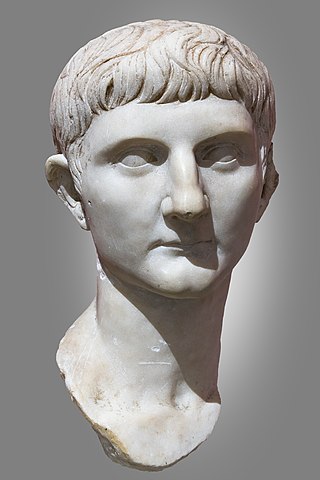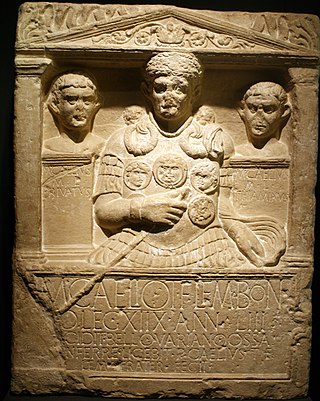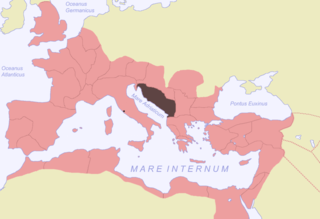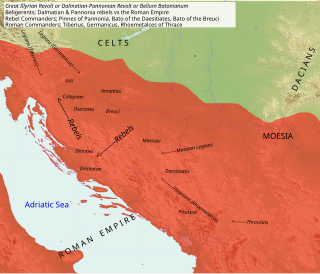
Germanicus Julius Caesar was an ancient Roman general and politician most famously known for his campaigns in Germania. The son of Nero Claudius Drusus and Antonia the Younger, Germanicus was born into an influential branch of the patrician gens Claudia. The agnomen Germanicus was added to his full name in 9 BC when it was posthumously awarded to his father in honor of his victories in Germania. In AD 4 he was adopted by his paternal uncle Tiberius, who succeeded Augustus as Roman emperor a decade later. As a result, Germanicus became an official member of the gens Julia, another prominent family, to which he was related on his mother's side. His connection to the Julii Caesares was further consolidated through a marriage between him and Agrippina the Elder, a granddaughter of Augustus. He was also the father of Caligula, the maternal grandfather of Nero, and the older brother of Claudius.

The Battle of the Teutoburg Forest, described as the Varian Disaster by Roman historians, took place at modern Kalkriese in AD 9, when an alliance of Germanic peoples ambushed Roman legions and their auxiliaries, led by Publius Quinctilius Varus. The alliance was led by Arminius, a Germanic officer of Varus's auxilia. Arminius had acquired Roman citizenship and had received a Roman military education, which enabled him to deceive the Roman commander methodically and anticipate the Roman army's tactical responses.

Legio XX Valeria Victrix, in English Twentieth Victorious Valeria Legion was a legion of the Imperial Roman army.
Marcus Valerius Messalla Messallinus was a Roman senator who was elected consul for 3 BC.

Illyricum was a Roman province that existed from 27 BC to sometime during the reign of Vespasian. The province comprised Illyria/Dalmatia in the south and Pannonia in the north. Illyria included the area along the east coast of the Adriatic Sea and its inland mountains, eventually being named Dalmatia. Pannonia included the northern plains that now are a part of Serbia, Croatia and Hungary. The area roughly corresponded to part or all of the territories of today's Albania, Kosovo, Montenegro, Serbia, Bosnia and Herzegovina, Croatia, and Slovenia.
Bato the Daesitiate was a chieftain of the Daesitiates, an Illyrian tribe which fought against the Roman Empire between 6 and 9 AD in a conflict known as Bellum Batonianum.

The Bellum Batonianum was a military conflict fought in the Roman province of Illyricum in the 1st century AD, in which an alliance of native peoples of the two regions of Illyricum, Dalmatia and Pannonia, revolted against the Romans. The rebellion began among native peoples who had been recruited as auxiliary troops for the Roman army. They were led by Bato the Daesitiate, a chieftain of the Daesitiatae in the central part of present-day Bosnia and Herzegovina, and were later joined by the Breuci, a tribe in Pannonia led by Bato the Breucian. Many other tribes in Illyria also joined the revolt.
The Amantini was the name of a Pannonian Illyrian tribe.

Daesitiates were an Illyrian tribe that lived on the territory of today's central Bosnia, during the time of the Roman Republic. Along with the Maezaei, the Daesitiates were part of the western group of Pannonians in Roman Dalmatia. They were prominent from the end of the 4th century BC up until the beginning of the 3rd century CE. Evidence of their daily activities can be found in literary sources, as well as in the rich material finds from Central Bosnian cultural group that is commonly associated with tribe of Daesitiates.
The history of Illyrian warfare of the Illyrians spans from the beginning of the 2nd millennium BC up to the 1st century AD in the region of Illyria and in southern Italy where the Iapygian civilization flourished.
Pinnes or Pinnetes was a Pannonian chieftain, who led a rebellion alongside Breucian chieftain Bato until Bato betrayed him and handed him over to the Romans, thus securing the rule over the Breuci.
The Osseriates were an Illyrian tribe in Pannonia. The Osseriates along with the Celtic Varciani and the Colapiani were created from the Breuci.
The Illyrians were a group of Indo-European speaking peoples, who inhabited the western Balkan Peninsula in ancient times. They constituted one of the three main Paleo-Balkan populations, along with the Thracians and Greeks.
The Roman–Dalmatian wars were a series of conflicts between the Dalmatae (Delmatae) and the Romans. After the fall of the Ardiaei in southern Illyria, the Dalmatae were to pose the greatest force against the Romans in their conquest of Illyria.

Central Bosnia is a central subregion of Bosnia, which consists of a core mountainous area with several basins, valleys and mountains. It is bordered by Bosnian Krajina to the northwest, Tropolje to the west, Herzegovina to the south, Sarajevo to the east and Tuzla to the northeast. It is a part of the Federation of Bosnia and Herzegovina and is divided between the Central Bosnia Canton and the Zenica-Doboj Canton, with a population of around 800,000. The largest city in the region is Zenica, with the Sarajevo-Zenica basin being the most densely populated area. Its highest peaks are Vranica, Šćit and Bitovnja.
Arduba was a settlement of the Illyrian tribe of the Daesitiates in Illyria. Following the Roman invasion, the settlement was included in the Roman province of Dalmatia. Arduba was located somewhere near the modern city of Zenica in Bosnia and Herzegovina. Most probably the royal city of Vranduk existed in the time of the Illyrians, under the name Arduba.
Bato is an Illyrian name.







